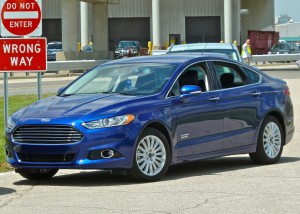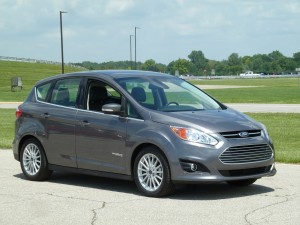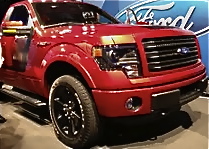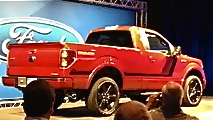Ford focuses on refinement for 2014
By John Gilbert
DETROIT, MI. — Ford Motor Company didn’t need any sweeping style changes for its cars and trucks for 2014, not after redesigning virtually its entire model line in the last two years. Therefore, Ford has turned its attention to refining its fuel-efficiency and technology leadership and to deal with the seeming contradiction that customer survey complaints for balky complexity of certain technology features for 2013 models were countered by unprecedented customer satisfaction numbers and high “take rates” on those same technology items.
Ford officials discussed those issues while showing off the new 2014 vehicles at the annual media preview at its Dearborn vehicle development facility in the last week of June. Included among the newest vehicles is a new Tremor version of the popular F-150 pickup line — a regular-cab model with special trim and a 365-horsepower EcoBoost V6.
The success of Ford’s EcoBoost technology is a major part of Ford’s new arsenal of engines, with those displacing 3.5, 2.0, and 1.6 liters adding turbocharging to earn the EcoBoost designation; they perform with the power of larger engines while getting the significantly better fuel economy of smaller displacements. This fall, Ford will unveil its unique 3-cylinder, 1.0-liter EcoBoost engine in the Fiesta subcompact.
Since getting a preliminary test drive in new models is a prime lure to get the media to attend this event, we all eagerly hustled out onto one of Ford’s test tracks to try the 1.0 EcoBoost, but we were told it won’t be out until this fall. We had to be satisfied by running the 1.6 EcoBoost Fiesta ST around an autocross course, which was impressive indeed.
Another Ford advancement is its expansion of hybrid technology in the Fusion, with the Fusion Energi promising fuel economy up to and beyond 100 miles per gallon. Our drive in the Energi was restricted to a no-passing, single-file pair of slow laps, including several stop-and-gos on each lap, which proved little, except that the plug-in hybrid will work seamlessly to switch back and forth from battery to gas engine when we get it in real-world driving this fall.
Ford officials said they are pleased with the popularity of products in the Midwest and are making a focused effort, to coin a phrase, on expanding their market share on both the East and West Coasts. Among its array of new products, Ford is compartmentalizing the Fusion, Escape, Focus, Fiesta and C-Max into what it calls the “Super Segment,” because all have the size and advanced technology to appeal particularly to West Coast buyers.
“Our hybrid sales have been strong with the C-Max and Fusion,” said Joe Hinrichs, Ford president of the Americas. “In the first five months of this year, we sold more hybrids than in any full year.”
And that’s before the 2014 Fusion Energi.
Some of Ford’s biggest news in the past year has been obscured by the black cloud of diminished initial-quality survey results for electronic connectivity twins SYNC and MyFordTouch, and the lack of smoothness of its new PowerShift direct-sequential automatic transmissions. Those of us who vote on North American Car of the Year have heard from fellow-jurors that some refused to vote for the Fusion because of those idiocyncracies, and Ford hasn’t overlooked them.
“We’ve cut the original MyFordTouch problems by half,” said Hinrichs. “And despite the complaints, the take rate on our technical features like SYNC and MyFordTouch are higher than any other company. Our PowerShift was criticized for a hesitation on shifts, but it is a DSG, which has a different feel because it doesn’t have a torque-converter. But the fuel-economy is improved, so people still order it. We have smoothed it out. That’s our goal — to improve the technology but eliminate issues like that.”
Raj Nair, group vice president for global product development, amplified Hinrichs’s statements. “MyFordTouch and PowerShift have been the main two problems for initial quality complaints, but we’ve had higher customer satisfaction on vehicles equipped with MyFordTouch,” said Nair. “We’ve reduced the problems by 50 percent, but even with the problems, 74 percent of our buyers said they would recommend MyFordTouch to their friends.”
It appears Ford’s connectivity issues are similar to advanced-technology smartphones; consumers want the latest technology, but that doesn’t mean they won’t grumble at complexities of operating them. Same with the PowerShift, which registers improved fuel economy.
“We also know we’ve got to improve the calibrations on our PowerShift,” said Nair. “But while we’re working to correct those problems, we’re happy with our customer satisfaction statistics, and our improved warranty claims.”
Hinrichs also took a subtle jab at more conservative competitors. “We want to keep our designs fresh,” said Hinrichs. “Leveraging global platforms helps spread out expenses, but new styling means more new launches. If you don’t change, you have a better chance of leading the initial quality surveys, because you’re just refining an old model. Our Fusion, Focus and Fiesta all have new platforms, but the customer satisfaction with our overall build quality is very good, and our warranty calls are at an all-time best.”
Hinrichs said the market research indicates a car’s design is its No. 1 purchase attraction, and fuel economy is No. 2. The stylish appearances of Ford’s newest models puts them among the design leaders, and the EcoBoost and hybrid advances in fuel efficiency bolster Ford’s status.
Popular as the midsize Fusion has been in its first year of redesign, with both EcoBoost and hybrid models, the top-mileage Fusion Energi we briefly drove, with a plug-in hybrid gas-electric powertrain that is estimated at topping 100 miles per gallon, will follow for 2014. In addition, the subcompact C-Max comes only with electric power or hybrid. One of the most intriguing new Ford products is the Fiesta, the sporty and high-mileage subcompact, which will add a surprisingly peppy 1.0-liter, 3-cylinder EcoBoost (turbocharged) model that should challenge or surpass 40 mpg.
Ford’s emphasis on cars for 2014 doesn’t mean it’s abandoning trucks, where it has reinforced its industry lead. The F-150 pickup, top-seller in the industry for 36 consecutive years, topped 70,000 units sold in May — the most since March of 2007 — representing an increase of 22 percent in sales. “We’re proud of our trucks,” said Hinrichs, attributing the increase to the popularity of the EcoBoost V6. “We’ve increased our truck market share to 30 percent.”
The F-150 family will grow by a new model in 2014 with the Tremor, which will appeal to those interested more in street performance than work-duty. It is a short, regular cab pickup with its EcoBoost 3.5 V6 developing 365 horsepower, and it announces its arrival with all sorts of decal trim stripes.
Comments
Tell me what you're thinking...
and oh, if you want a pic to show with your comment, go get a gravatar!







 John Gilbert is a lifetime Minnesotan and career journalist, specializing in cars and sports during and since spending 30 years at the Minneapolis Tribune, now the Star Tribune. More recently, he has continued translating the high-tech world of autos and sharing his passionate insights as a freelance writer/photographer/broadcaster. A member of the prestigious North American Car and Truck of the Year jury since 1993. John can be heard Monday-Friday from 9-11am on 610 KDAL(www.kdal610.com) on the "John Gilbert Show," and writes a column in the Duluth Reader.
John Gilbert is a lifetime Minnesotan and career journalist, specializing in cars and sports during and since spending 30 years at the Minneapolis Tribune, now the Star Tribune. More recently, he has continued translating the high-tech world of autos and sharing his passionate insights as a freelance writer/photographer/broadcaster. A member of the prestigious North American Car and Truck of the Year jury since 1993. John can be heard Monday-Friday from 9-11am on 610 KDAL(www.kdal610.com) on the "John Gilbert Show," and writes a column in the Duluth Reader.